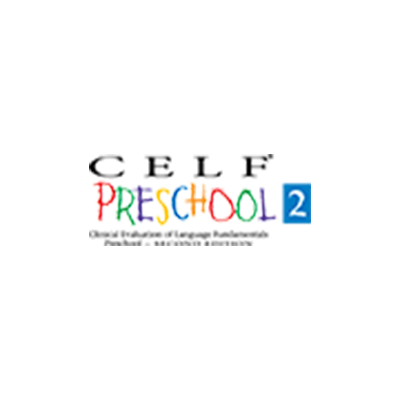Eleanor Semel, EdD, Elisabeth H. Wiig, PhD, Wayne A. Secord, PhD
Overview:Evaluate a broad range of language skills in preschool children, while meeting IDEA mandates
Age Range:3:0 to 6:11
Administration:Verbal response to stimulus picture
RTI Tiers:RTI Levels 2 and 3
Completion Time:Level 1: 15-20 minutes. Entire test: variable.
Norms:More than 800 preschool-age children
Scores/Interpretation:Core language score, receptive and expressive language index scores, expressive language, language content, and language structure index scores; standard scores, percentile ranks, age equivalents, and growth scores.
Publication Date:2004
The testing of choice used to evaluate those aspects of language necessary for preschool children to make the transition to the classroom. Comprehensively measures a broad range of language skills for children age 3-6 years, while meeting IDEA mandates.
- Includes a variety of subtests, including a pre-literacy scale, that provides in-depth assessment of a child’s language skills
- A pragmatics profile helps to describe the child’s language use at school or at home
- Results guide you in developing successful intervention planning
- Illustrations are age-appropriate and engaging
More than 1,500 preschool-aged children participated in the standardization.
New Growth Scores and Growth Charts provide an objective, quantitative measuer of a child’s progress.

Features & Benefits
The language assessment specifically designed for preschool aged children who are bound for the classroom
CELF Preschool-2 provides a variety of subtests to comprehensively test the language skills of preschool-aged children who will be in an academic-oriented setting.
- Includes a variety of subtests that provide in-depth assessment of a child’s language skills.
- Includes a pre-literacy scale and phonological awareness subtest.
- A pragmatics profile helps to describe the child’s language use at school or at home.
- Contains interesting, age appropriate, full-color pictures to hold the child’s attention.
- Meets current IDEA guidelines.
- More than 1,500 children participated in standardization, reliability, and validity studies.
Areas of Assessment
Subtests include: Concepts and Following Directions, Word Structure, Expressive Vocabulary, Recalling Sentences, Sentence Structure, Basic Concepts, Recalling Sentences in Context, Word Classes and Phonological Awareness.
Resources and Case Studies
CELF Preschool-2 Growth Scores and Growth Charts (PDF – 1512 KB)
CELF Preschool-2 Case Study (PDF – 2 MB)
CELF-P2 Preschool Case Studies (PDF – 403 KB)
PLS-5/CELF Preschool-2 Comparison (PDF – 222 KB)
Pre-recorded Webinars
-
PLS-5 and CELF Preschool 2: Case Studies
Presenter: Adam Scheller, PhD

Using PLS-5 and CELF Preschool-2 case studies, this session provided information for selecting the test most appropriate for assessing language skills of a preschool child. This session reviewed the tests’ purpose and design and differences between the test formats, research samples, and test results. Guidelines were provided for selecting the appropriate test and interpreting score results.
Date: Dec 07, 2017
-
Language Assessment in Early Childhood: CELF Preschool-2 and PLS-5 Case Studies
Presenter: Adam Scheller, PhD

The assessment of a child’s language during the preschool years can be complex, not only due to variability in skill development, but also because of the differences between school and early childhood service criteria. By choosing an appropriate assessment battery based on strengths of the instrument, an SLP is often able to overcome the issue of qualifying children with different functional communication levels. During this webinar, participants will review best practice principles for early language assessment and learn how to choose between two widely-used comprehensive language batteries, the PLS-5 and CELF Preschool 2. Examples and analysis of common pre-schooler profiles will be provided through case studies.
Date: Mar 23, 2017
 PDF: Language Assessment in Early Childhood: CELF Preschool-2 and PLS-5 Case Studies
PDF: Language Assessment in Early Childhood: CELF Preschool-2 and PLS-5 Case Studies Video: Language Assessment in Early Childhood: CELF Preschool-2 and PLS-5 Case Studies
Video: Language Assessment in Early Childhood: CELF Preschool-2 and PLS-5 Case Studies -
PLS-5 & CELF Preschool-2: Matching Assessment to a Child’s Language Profile
Presenter: Adam Scheller, Ph.D.

While the Preschool Language Scale-5 (PLS-5) and CELF Preschool-2 are both used to assess semantics, morphosyntax, pragmatics, and emerging literacy skills in young children, the tests provide different information about a child’s pattern of language strengths and weaknesses. This session will provide clinicians with information about differences in the tests’ purpose and design, guidelines for selecting the appropriate test based on referral concerns, and interpretation of test results. At the end of this session, clinicians will be able to select the appropriate test based on a child’s language ability and correctly interpret test results, enabling clinicians to set targeted programming recommendations for the young children they assess.
Date: Dec 14, 2016
 PDF: PLS-5 & CELF Preschool-2: Matching Assessment to a Child’s Language Profile
PDF: PLS-5 & CELF Preschool-2: Matching Assessment to a Child’s Language Profile Video: PLS-5 & CELF Preschool-2: Matching Assessment to a Child’s Language Profile
Video: PLS-5 & CELF Preschool-2: Matching Assessment to a Child’s Language Profile -
Accurately Interpreting Test Results When Assessing Young Preschoolers
Presenter: Adam Scheller, PhD

This session will provide an overview of PLS-5 and CELF Preschool-2 development to assist clinicians to better understand the test items, research samples, and test results. Guidelines for interpreting test results will be provided so that clinicians can make appropriate programming recommendations for the children they are assessing.
Learning Outcomes
At the completion of the webinar, participants will be able to:
- List at least two procedures conducted to update test items and normative data in a revised edition of a test.
- Describe at least one reason why test scores can change when norms are updated.
- Describe at least one reason why PLS-5 test items may appear at the same or at a different developmental age listed for PLS-4.
- Name at least one reason a PLS-5 standard scores results can be either lower or higher than on other developmental scales or tests.
Date: Apr 22, 2014
 Video: Accurately Interpreting Test Results When Assessing Young Preschoolers
Video: Accurately Interpreting Test Results When Assessing Young Preschoolers





